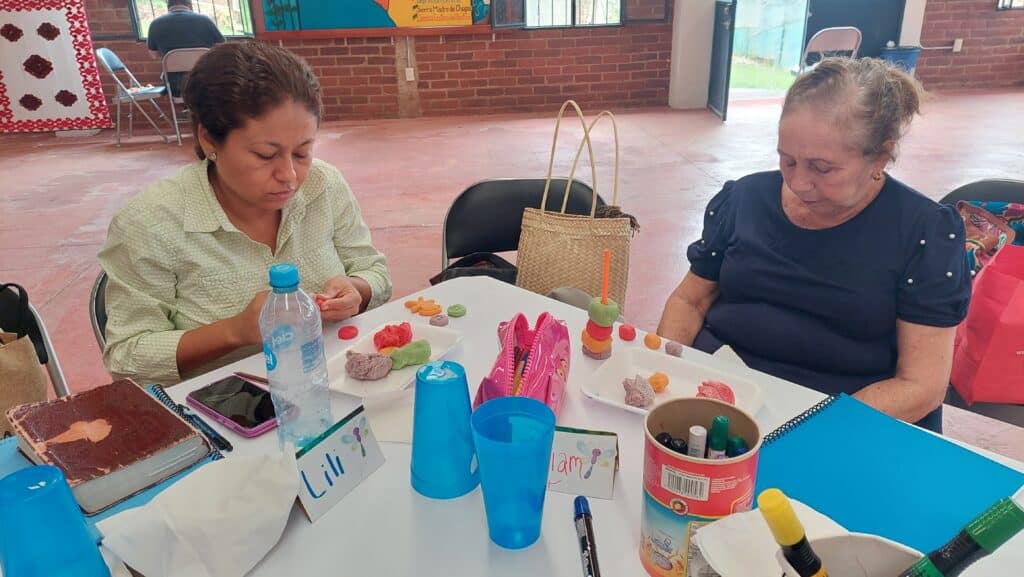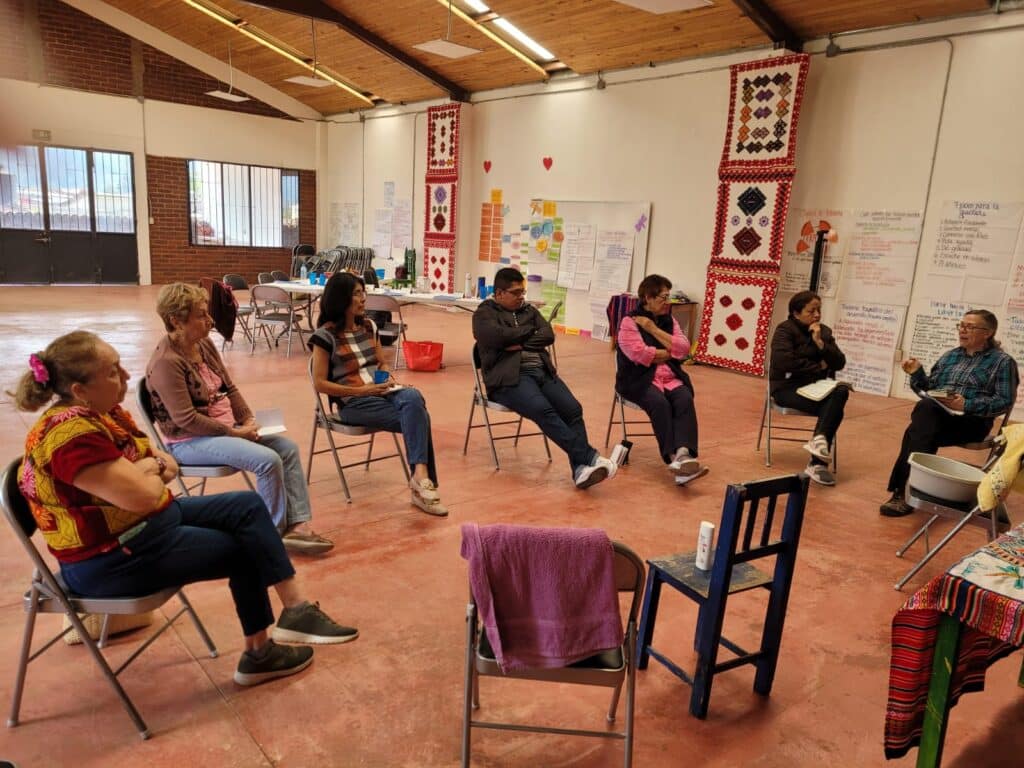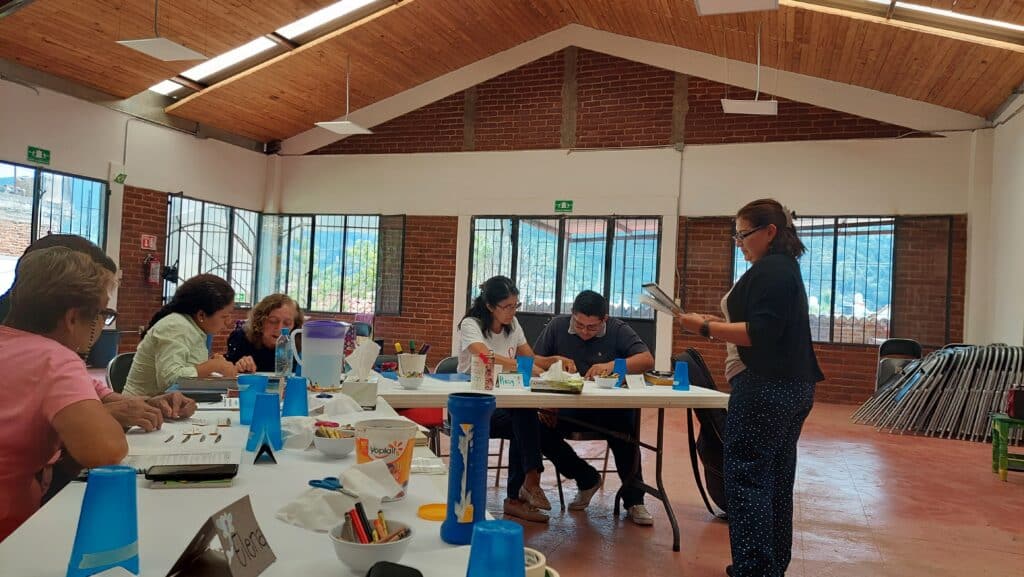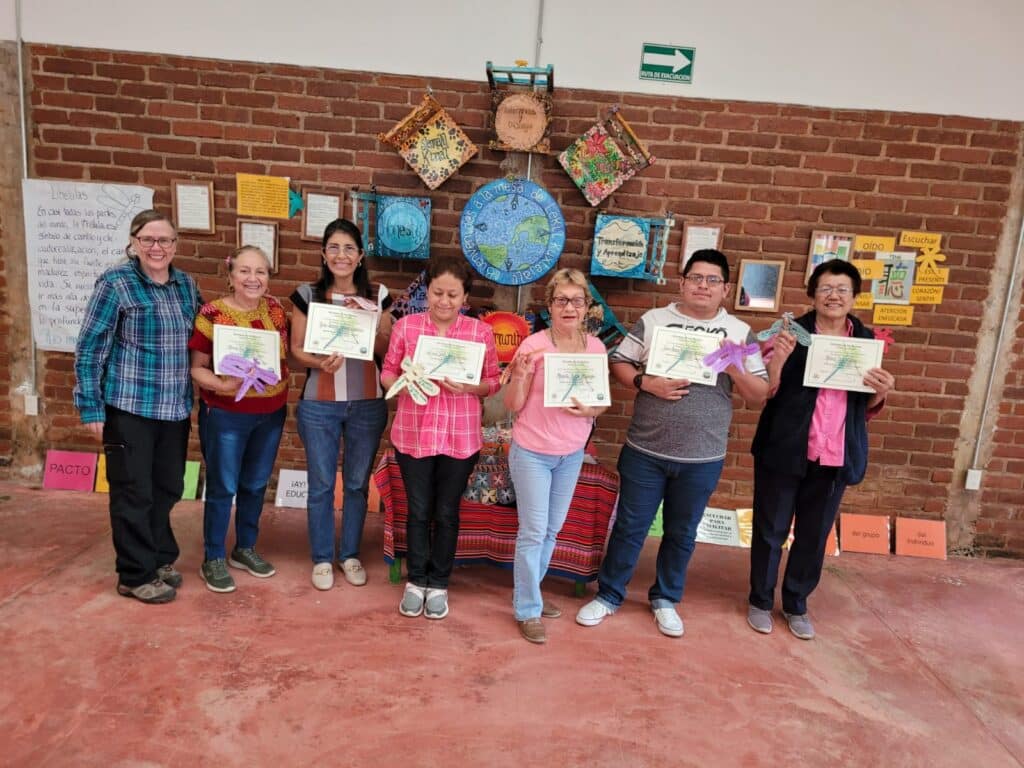Telling Our Stories
By Elena Huegel
Elena Huegel serves with the Intercultural Research and Studies Institute (INESIN) in Mexico.
Each participant in the Retoños en las ruinas: esperanza en el trauma (Roots in the ruins: hope in trauma) program has stories to share; stories of hope, joy, and connection; stories of pain, loss, and despair. When the group from the Good Shepherd (Buen Pastor) denomination gathers at the Institute for Intercultural Studies and Research in Chiapas, México, or the group from the Mesa Conjunta, a joint effort of the Congregational Churches of Mexico, Confraternity of Christian Churches (Disciples of Christ) in the Mexican Republic, and Christian Church (Disciples of Christ) of Mexico and for all the Nations, comes together at the summer institute, we find new ways to share our stories, challenging ourselves to observe different points of view or to explore our traumas through different lenses.

Sister Miriam Ríos Rodríguez shared her reflections on the impact of telling her story during the courses in Chiapas.
1. “First, I thank the Lord for the opportunity to participate in the Retoños en las ruinas program. I have been thinking about the things that I have learned and that are helping to bring about the fullness of life in my family and community. Even though there are always difficulties to be resolved at home, thanks to this course, I have found ways to bless my family.“
- I have found little ways to make my husband’s life more joyous and discovered that my personality helps me to do this. I recognize that laughter and playfulness are signs of our healing.
- I am trying to listen to my children, to share my learning with them, to recognize their dignity.
- I am helping my grandchildren to eat healthy while learning about our customs and values.
2. In my interactions with people from the indigenous communities in our area, I am more aware than ever how important it is that I uphold their dignity by being kind, listening attentively, really seeing each person, and serving them with sincerity and joy. I have stood in solidarity with my indigenous friends by praying, accompanying, and cooperating in any way I can.
3. I am teaching my family to reconnect with nature and with each other across generations and with our ancestors.
- I have a small garden with medicinal and ornamental plants.
- I am teaching my grandchildren to love and to care for these plants.
- I am teaching my grandchildren to respect and care for the water that gives us life.
- I am using the wise sayings and proverbs from my culture to teach my grandchildren right living.
- I am using positive jokes, funny observations, and lots of laughter to hand down the wisdom I have gained to my children and grandchildren.
4. I have found new ways to be in touch with members of my church through social media sharing prayers and Bible verses.

Pastor Zain Ángel Rodríguez Mendoza from the Disciples Church in San Luis Potosí wrote the following prayer of blessing for all the participants who are on their way to becoming facilitators in the program as he reflected on his story after a week of learning.
“I give thanks to the Lord of life for pouring out grace this week, anointing our memories, healing our hearts and opening a path to wholeness and freedom. May the stories told, the knowledge acquired, the open hearts, and even the denial or rejection, be blessed in God’s name. May this course which finishes today challenge us to persevere in the process of living life fully, and may you, Lord, continue to rub salve on our wounds, give rest for the broken, and be our light in the darkness. As a team of servants, we present to you all that our efforts might achieve, not as a debt to be paid, but as a symbol of our trust that whatever we experience will be according to your designs and will. We lay before you the exhaustion, challenges, and pain that we have identified in our communities. We give you every word we have spoken and heard, every embrace shared and received, every moment of tension and release. Even the burdens that we have taken up this week are yours knowing it is time to trust and let go. May your peace fill our minds and bring rest to our bodies and spirits. We give thanks with the assurance that every heart-felt story shared along with all that has been said and done has been consecrated by the blessed presence of your Holy Spirit in this place.” Amen.
Our identity, along with our sense of what is normal, can be damaged by our traumas. When we find new ways to tell and reframe our story, we can start on the path that leads from our narrow identity as victims to a broader view as wounded healers. (Henri Nouwen and Drs. Karl and Evelyn Bartsch) I would like to share with you one of the story telling exercises from the Retoños program.

Shaping a symbol of our identity change
Use the following recipe to create your own playdough. One of the participants in our courses is highly allergic to commercially made playdough. He nearly wiggled in delight when we made this homemade dough that he could shape safely. “I haven´t ever been able to touch modeling clay or playdough, and something from my childhood broke free as I squeezed and rolled, delighting in the soft texture in my hands. Thank you so much for this small but significant gift.” Once you have created the dough together, share the sensations you feel while working with your hands. Then, with a soft music playing in the background, each person creates a symbol that represents an experience, relationship or understanding that has shaped their identity. The symbol can be abstract or concrete. Each person chooses to share what they would like with the group about their identity and insights they may have gained.
Ingredients:
- 1 cup of white flour (without baking powder)
- 1 cup of warm water
- 2 tablespoons of salt
- 2 tablespoons of cooking oil
- 1 package of commercial gelatin (any brand and flavor)
Mix the ingredients in a small pot. Cook on medium heat until the mixture begins to stick and creates a ball. This step will take a little while, but just keep mixing until you can´t mix anymore! Remove the ball from the pot and let cool for 20 minutes on a cutting board dusted with flour. Be sure to soak the pot in water for easy clean up. Knead the dough while adding flour bit by bit until it is no longer sticky. The gelatin will give color and a pleasant smell but food coloring can be added for brightness. The dough can be saved for several weeks in an airtight container or bag in the refrigerator. If it gets sticky again, add more flour. I usually make one batch for each color: grape gelatin for purple, strawberry gelatin for red and so on.
Elena Huegel serves with the Intercultural Research and Studies Institute (INESIN) in Mexico. Her appointment is made possible by your gifts to Disciples Mission Fund, Our Church’s Wider Mission, and your special gifts.

